Semi Leotax
The Semi Leotax is a series of Japanese 4.5×6 folders made by Shōwa Kōgaku,[1] the company that also made the Leotax Leica copies. The cameras were distributed by Misuzu Shōkai before and during the war.
Contents
First generation, with folding finder
The first generation of Semi Leotax are vertical folders, copies of the 4.5×6 Nettar. They have plain diagonal struts, a body release and a folding optical finder. The back is hinged to the left — as seen by the photographer holding the camera horizontally — and is opened by a sliding bar on the right. The lens is focused by turning the front cell on all the models.
General description of the wartime cameras
The wartime cameras have two red windows near the top of the back, protected by a horizontally sliding common cover. The lens standard has a corner protruding at the top right (as seen from the front), to attach a removable brilliant finder. The model name SEMI LEOTAX in a hexagon is embossed in the leather covering at the front, and the company name SHOWA KOGAKU is embossed in another hexagon on the back.
Original version, manual film advance
The original version, released in 1940, has manual film advance. It is not known if it was driven by a key or a knob.
This version is only known from advertisements dated May and November 1940,[2] and no surviving example has been observed so far. The November advertisement in Asahi Camera[3] offers the camera as a new model with a T, B, 1–200 shutter apparently called New Torio[4] and a Riese-Anastigmat 7.5cm lens in a choice of f/3.5 or f/4.5 maximum aperture. No price is indicated but it is said that the official price was ¥155.[5]
The official list of set prices compiled in October 1940 and published in January 1941 has six versions of the Semi Leotax, called "Semi Leotax I" (¥80), "Semi Leotax II" (¥100), "Semi Leotax III" (¥100 too), "Semi Leotax IV" (¥120), "Semi Leotax V" (¥121) and "Semi Leotax VI" (¥160).[6] From the features of other cameras classified in the same price categories, it is likely that the model I has an f/4.5 lens and a shutter with no slow speeds, the models II and III have an f/4.5 lens and a better shutter, the model IV has an f/3.5 lens and the same shutter, whereas the models V and VI presumably correspond to the f/4.5 and f/3.5 versions with auto-stop advance (see below).
Auto-stop version
A new version was released in 1941 with auto-stop film advance.[7] The mechanism is contained in a small housing on the bottom plate, under the advance knob. Behind the housing is a small sliding button certainly used to unlock the mechanism. The housing is engraved with the name Leotax and the serial number, and it contains a small window, perhaps displaying an exposure counter.
Documents

|
| Extract of a leaflet by Kankyū Hyakkaten. Click on the image for a translation. (Image rights) |
The auto-stop version was first advertised in March 1941, and was featured in the new products column of the May issue of Asahi Camera.[8] The September 1941 advertisement in Asahi Camera mentions a New Torio shutter (T, B, 1–200) and a Riese-Anastigmat 7.5cm lens, and gives the following price list:[9]
- Semi Leotax V, f/4.5 lens, ¥115;
- Semi Leotax VI, f/3.5 lens, ¥140;
- ever-ready case, ¥6.50;
- dedicated lens hood, ¥1.80.
The leaflet by Kankyū Hyakkaten reproduced in this page is perhaps dated 1941.[10] The picture is the same as in the September advertisement in Asahi Camera, and the information is very similar, except that the document does not mention the model numbers or the hood.
The official list of set prices dated November 1941 has the "Semi Leotax V", "Semi Leotax VI" and "Semi Leotax 7", attributed to Shōwa Kōgaku.[11] The Semi Leotax 7 is listed in the same price category as the model VI, and might correspond to the version with self-timer mentioned below.
The April 1943 government inquiry on Japanese camera production has two versions of the Semi Leotax, both with an f/3.5 Riese lens, attributed to Fujita, and a New Torio shutter (T, B, 1–200), attributed to Nippon Kōsokki.[12] They only differ by the presence or absence of a self-timer.
The advertisement in Shashin Bunka October 1943 lists the same two versions, for respectively ¥189 and ¥216; the f/4.5 lens is not mentioned any more.[13] The document uses the same picture as in the September 1941 advertisement and in the above leaflet.
Advertisements for the Semi Leotax with auto-stop advance are reported until September 1944.[14] Rangefinder conversions were offered in 1943 by Hakkōdō for the Semi Leotax and various other copies of the Ikonta or Nettar (see this page).
Actual examples
The advertising picture shows a black auto-stop housing; but in actual examples, it has been observed in black and in chrome finish. The lens rim reads RIESE-ANASTIGMAT in the advertising pictures, but it seems that actual examples have RIESE-ANASTIGMAT for the f/4.5 lens and RIEZE-ANASTIGMAT for the f/3.5. The lenses have no serial number.
The shutter is usually engraved NEW TORIO in the speed rim but one example has been observed with a shutter marked NEW TORIO II giving 300–1, B, T speeds arranged in the reverse direction.[15] Kokusan kamera no rekishi suggests that the self-timer equipped model has an Orient A shutter, but none has yet been observed.[16]
Some images of the new model Semi Leotax . The lens is the Riese-Anastigmat 7.5cm f3.5 version, there is a 4 digit serial number on the rear of the lens' fastening ring.
Center of the top plate is the simple viewing frame that pops up when the button on the right is depressed, whilst the button on the left releases the New Torio T, B, 1–200 shutter mechanism. It also fashioned flash and cable release sockets round the circumference. Focus ring has distance markings from 1.5, 2, 2.5, 3, 4, 5, 6, 7.5, 8, 10, 20, infinity mtr.
The film advance is by a knob on the bottom right of the base plate looking from the rear, it is coupled to the film counter auto-stop advance feature and can display the maximum of 16 shots from a 120 roll film, from the tiny display window, just below the Leotax logo & 4 digit serial number. The counter is not as straight forward to operate since its a lever/gearing coupled inside to lock down the advance knob once the film advance cycle is completed. To advance, just slide the spring loaded lever to the right turn the knob (direction of a engraved curved arrow) until the next number appears, then release it - keep on turning until it clicks and locks the knob. On the other side of the base is the tripod mount socket.
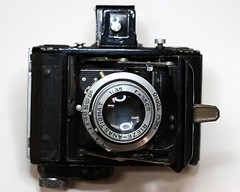 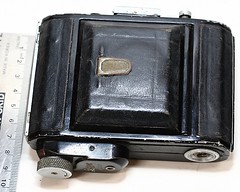 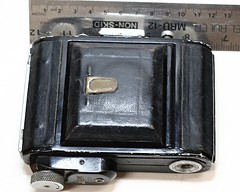
|
 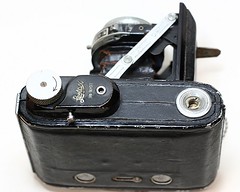 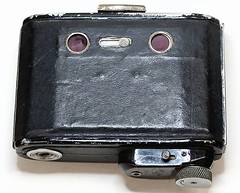
|
| Semi Leotax VI no.9207, Rieze-Anastigmat 7.5cm f/3.5 lens, New Torio shutter (T, B, 1–200), black advance cover. The body covering was replaced, and the flash synchronization is not original. Pictures courtesy of SS Thow. (Image rights) |
Postwar version
 
|

|

|

|

| |
|
Postwar Semi Leotax, two red windows, bright chrome finder, "MIOJ" marking, | ||

|
| C. Reginon Anastigmat 7.5cm f/3.5 lens, N.K.K. Wester shutter (T, B, 1–200, no synch). Picture courtesy of John Gilbert. (Image rights) |
The production of the camera was resumed at the end of 1949.[17] The postwar version has no auto-stop feature and a key for film advance.[18] Other differences are the ¼-inch tripod screw thread and the metal-plated finder's front part. The front leather is embossed SEMI LEOTAX and the back leather is embossed SOW for Showa Optical Works.
It seems that the first cameras have a Wester Anastigmat 75/3.5. A presumably early example is reported with this lens and a Northter Model 1 shutter by Nishida, engraved N.S.D. on the speed rim.[19]

|
| Postwar Semi Leotax, satin chrome finder, N.K.K. Wester shutter (B, 1–200, synch pin). Picture courtesy of eBayer dlk2. (Image rights) |
Most examples have a C. Reginon Anastigmat 7.5cm f/3.5 lens and a Wester shutter. The Wester shutter has a self-timer and is engraved N.K.K. at the bottom of the speed rim. The early examples have T, B, 1–200 speeds and a WESTER marking in silver letters at the bottom of the shutter plate. Some are synchronized (via a single pin at the bottom right) and some are not. The late examples have no T setting and a WESTER marking in black letters at the top of the shutter plate; they all have a synch pin.

|
| "Made in Occupied Japan" marking Picture courtesy of John Gilbert. (Image rights) |
A single example has been observed with a Nitto Kominar 7.5cm f/3.5 lens and a Copal shutter (B, 1–200) with an ASA bayonet synch post.[20]
At some point, the two red windows were replaced by a single one at the bottom left of the back, protected by a smoothly integrated retractible cover. This was perhaps simultaneous with the switch of the viewfinder's front part from bright chrome to satin chrome finish. These changes were contemporary to the adoption of the Wester shutter with no T setting. Some examples are engraved Made in Occupied Japan on the rear of the folding finder, before and after the mentioned changes.
The postwar Semi Leotax with folding finder was still pictured in an advertisement dated December 1950,[21] whose text describes the new model to come.
  
|
  
|
|
Postwar Semi Leotax, single red window, satin chrome finder, |
Tubular finder model
Description and early mentions
  
|
      
|
| Semi Leotax New or DL, S. Reginon 7.5cm f/3.5 lens no.1801, N.K.K. Wester shutter (B, 1–200), synch pin at the bottom. Pictures courtesy of eBayer Costellochris. (Image rights) |
A New Semi Leotax was announced in the December 1950 advertisement cited above, with an uncoupled rangefinder that would only appear 18 months later on the DL II. The description mentions three-element folding struts (like the Ikonta), a chrome finish top plate and a chrome frame around the folding bed. The shutter is announced as a Copal giving B, 1–200 speeds and the lens as a Yōkō (ヨーコー) 75/3.5 made by Olympus. This is likely to be a typo either for the Olympus-made Zuiko (ズイコー) lens or for the Toko (トーコー) lens that was not made by Olympus but by Tōkyō Kōgaku.
The actual Semi Leotax New (セミ・レオタックス新型) has all these features but for the rangefinder and the lens and shutter equipment. There is a rectangular metal plate supporting the accessory shoe and the tubular finder mounted on a parallax correction device, manually actuated by a small sliding button. This button is moved between the infinity position and the close distance position marked 4 or sometimes 3.5. The release button is heavier than that of the previous model and has a screw-thread to attach a distant-release connector.
The advance key has a more squarish shape than before and the folding bed release has moved to the bottom plate. The back has a single red window at the bottom, protected by a vertically sliding cover.
The front leather is embossed SEMI LEOTAX. The back leather is embossed SOW for Showa Optical Works and the same logo is engraved in the folding struts. Some cases are embossed Semi Leotax and some SOW.
An advertisement dated August 1951[22] mentioned a Reginon or Kominar 75/3.5 lens and a Wester or Copal B, 1–200 shutter.
Renamed Semi Leotax DL
  
|
  
|
| Semi Leotax DL, Toko 7.5cm f/3.5 lens no.110xxx, Copal shutter (B, 1–200), ASA synch post. Pictures courtesy of eBayer Jsahm. (Image rights) |
The camera was renamed Semi Leotax DL at the end of 1952[23], with no apparent change. An advertisement dated January 1953[24] offered the following versions:
- Toko 7.5cm f/3.5 lens by Tōkyō Kōgaku, Copal B, 1–200 shutter (¥14,500);
- Kominar 7.5cm f/3.5 lens by Nittō Kōgaku, Copal B, 1–200 shutter (¥13,500);
- Reginon 7.5cm f/3.5 lens, Wester B, 1–200 shutter by Nishida (¥12,500).
A flash unit called Leotax High-Power Flash BCB (レオタックス強力発光機BCB型) was offered together for ¥2,500. It is not known if it is related with the contemporary Nikon BCB flash unit.
All three lens and shutter combinations have been observed on actual examples. The Reginon lens is engraved S-REGINON and is said to have three elements.[25] The Wester shutter is engraved N.K.K. in the speed rim and exists in three versions. The older one is marked WESTER at the top of the shutter plate and has a single pin synch post at the bottom right. The next one is marked WESTER at the bottom and has an ASA synch post at the top right, and the last one has a PC synch post at the same place.[26] All the Copal shutters have an ASA synch post at the top right.
  
|
| Semi Leotax New or DL, S. Reginon 7.5cm f/3.5 lens no.4804, N.K.K. Wester shutter (B, 1–200), ASA synch post. Pictures courtesy of eBayer Dugwerks. (Image rights) |
A further lens and shutter combination has been observed, consisting of a Kominar 7.5cm f/3.5 lens and a B, 1–200 shutter with self-timer and a PC synch post at the bottom right, marked NEW TRIO at the bottom and with a three-letter acronym ending in "K" on the speed rim.
Rangefinder model
The rangefinder model was announced in May 1952 as the Semi Leotax DL II, with Copal shutter and Toko 75/3.5 lens.[27] It was soon renamed Semi Leotax R and was sold under that name from 1952 to early 1955.[28]
The camera has a top housing containing the viewfinder in the middle, surrounded by the uncoupled rangefinder's windows. The rangefinder eyepiece is on the left of the finder and the distance setting knob falls under the right thumb. The distance is read in a small window in the top housing, to the right of the accessory shoe. The top plate is engraved SEMI LEOTAX and Showa Optical Works, Ltd. The serial number is engraved in front of the shoe. The rest of the body is similar to the Semi Leotax DL.
At the beginning, the lens and shutter equipment was a Toko 7.5cm f/3.5 by Tōkyō Kōgaku and a Copal shutter giving B, 1–200 speeds and synchronized via an ASA bayonet post. An advertisement dated January 1953[29] offered this version for ¥18,500, and at least one surviving example is known.[30]
A later advertisement, dated September 1954[31], offered the following combinations:
- Toko 7.5cm f/3.5 lens by Tōkyō Kōgaku, Copal B, 1–300 shutter, self-timer, PC synch post (¥17,200);
- Kominar 7.5cm f/3.5 lens by Nittō Kōgaku, Copal B, 1–300 shutter, self-timer, PC synch post (¥16,100);
- Reginon 75/3.5 lens, Wester B, 1–200 shutter by Nishida, self-timer, ASA synch post (¥15,000).[32]
All three variants have been observed and are confirmed to exist.[33]
Notes
- ↑ The company was called Shōwa Kōgaku Seiki after the war. For the prewar and wartime period, Kokusan kamera no rekishi, p.343, gives the name "Shōwa Kōgaku Kōgyō-sha" for the original Leotax.
- ↑ Kokusan kamera no rekishi, p.343.
- ↑ Advertisement reproduced in Kokusan kamera no rekishi, p.103.
- ↑ New Torio is the name appearing on the auto-stop version, and the advertising picture seems to read the same.
- ↑ Lewis, p.56.
- ↑ "Kokusan shashinki no kōtei kakaku", type 3, sections 3B, 4B, 5B, 6B and 7B.
- ↑ It is the version called "Semi-Leotax (1941)" in McKeown, p.892 and "Semi Leotax I" in Sugiyama, item 1159.
- ↑ Kokusan kamera no rekishi, p.343.
- ↑ Advertisement reproduced in Kokusan kamera no rekishi, p.103.
- ↑ Leaflet by Kankyū Hyakkaten reproduced in this page.
- ↑ "Kamera no kōtei kakaku kanpō happyō", November 1941, type 3, sections 6B and 7B.
- ↑ "Kokusan shashinki no genjōchōsa" ("Inquiry into Japanese cameras"), items 35–6, lens item Lb1, shutter items 18-P-8 and 18-P-24.
- ↑ Advertisement reproduced in Kokusan kamera no rekishi, p.103.
- ↑ Kokusan kamera no rekishi, p.343.
- ↑ Example sold in an eBay auction, body N°14701.
- ↑ Kokusan kamera no rekishi, p.343.
- ↑ Kokusan kamera no rekishi, p.343.
- ↑ It is the version that is called "Semi-Leotax (postwar)" in McKeown, p.893, mistakenly illustrated with a picture of the later Semi Leotax New or DL.
- ↑ Example pictured in this page of Wakamiya's site.
- ↑ Example pictured in this post at photo.net.
- ↑ Advertisement published in Asahi Camera, reproduced in Kokusan kamera no rekishi, p.211.
- ↑ Advertisement published in Asahi Camera, reproduced in Kokusan kamera no rekishi, p.211.
- ↑ Date: advertisements mentioned in Kokusan kamera no rekishi, p.374.
- ↑ Advertisement published in Asahi Camera, reproduced in Kokusan kamera no rekishi, p.212.
- ↑ According to this page at Orio's Modern Classic Cameras, by someone who disassembled the S-Reginon lens of a Semi Leotax R.
- ↑ The version with PC synch post is pictured in this page of the AJCC.
- ↑ Date: Kokusan kamera no rekishi, p.374. The advertisement published in Asahi Camera is reproduced on p.212.
- ↑ Dates: advertisements mentioned in Kokusan kamera no rekishi, p.374.
- ↑ Advertisement published in Asahi Camera, reproduced in Kokusan kamera no rekishi, p.212.
- ↑ Example observed in an online auction.
- ↑ Published in Asahi Camera, reproduced in Kokusan kamera no rekishi, p.212.
- ↑ This is the variant pictured in this page at Orio's Modern Classic Cameras.
- ↑ Examples observed in various online auctions.
Bibliography
Original documents
- "Kamera no kōtei kakaku kanpō happyō" (カメラの公定価格官報発表, Official announcement of the set prices of the cameras), November 1941. Extract of a table listing Japanese camera production and setting the retail prices, reproduced in "Bebī Semi Fāsuto 'Kore ha bebī wo nanotta semi-ki da'" (ベビーセミファースト"これはベビーを名乗ったセミ機だ", Baby Semi First, 'this is a Semi camera called Baby'), an article by Furukawa Yasuo (古川保男) in Camera Collectors' News no. 277 (July 2000). Nishinomiya: Camera Collectors News-sha. P. 27. Type 3, sections 6B and 7B.
- Kankyū Hyakkaten. Leaflet for the New Midget II, Romax, Semi Leotax and Well Standard. Date not indicated, perhaps c.1941. Document reproduced in this Flickr album by Rebollo_fr.
- "Kokusan shashinki no genjōchōsa" (国産写真機ノ現状調査, Inquiry into Japanese cameras), listing Japanese camera production as of April 1943. Reproduced in Supuringu kamera de ikou: Zen 69 kishu no shōkai to tsukaikata (スプリングカメラでいこう: 全69機種の紹介と使い方, Let's try spring cameras: Presentation and use of 69 machines). Tokyo: Shashinkogyo Syuppan-sha, 2004. ISBN 4-87956-072-3. Pp.180–7. Items 35–6.
- "Kokusan shashinki no kōtei kakaku" (国産写真機の公定価格, Set prices of the Japanese cameras), listing Japanese camera production as of October 25, 1940 and setting the retail prices from December 10, 1940. Published in Asahi Camera January 1941 and reproduced in Shōwa 10—40nen kōkoku ni miru kokusan kamera no rekishi (昭和10〜40年広告にみる国産カメラの歴史, Japanese camera history as seen in advertisements, 1935—1965). Tokyo: Asahi Shinbunsha, 1994. ISBN 4-02-330312-7. Pp.108—9. Type 3, sections 3B, 4B, 5B, 6B and 7B.
Recent sources
- Asahi Camera (アサヒカメラ) editorial staff. Shōwa 10–40nen kōkoku ni miru kokusan kamera no rekishi (昭和10–40年広告にみる国産カメラの歴史, Japanese camera history as seen in advertisements, 1935–1965). Tokyo: Asahi Shinbunsha, 1994. ISBN 4-02-330312-7. Items 316–7 and 1036–40.
- Kawamata Masataku (川又正卓). Semi Leotax. In Supuringu kamera de ikou: Zen 69 kishu no shōkai to tsukaikata (スプリングカメラでいこう: 全69機種の紹介と使い方, Let's try spring cameras: The use of and actual examples from 69 machines). Tokyo: Shashinkogyo Syuppan-sha, 2004. ISBN 4-87956-072-3. Pp. 92–3.
- Lewis, Gordon, ed. The History of the Japanese Camera. Rochester, N.Y.: George Eastman House, International Museum of Photography & Film, 1991. ISBN 0-935398-17-1 (paper), 0-935398-16-3 (hard). Pp.56, 73, 75 (brief mentions only).
- McKeown, James M. and Joan C. McKeown's Price Guide to Antique and Classic Cameras, 12th Edition, 2005-2006. USA, Centennial Photo Service, 2004. ISBN 0-931838-40-1 (hardcover). ISBN 0-931838-41-X (softcover). Pp.892–3.
- Sugiyama, Kōichi (杉山浩一); Naoi, Hiroaki (直井浩明); Bullock, John R. The Collector's Guide to Japanese Cameras. 国産カメラ図鑑 (Kokusan kamera zukan). Tokyo: Asahi Sonorama, 1985. ISBN 4-257-03187-5. Items 1159 and 1318–21.
Links
In English:
- Postwar Semi Leotax with Copal shutter in a post at photo.net
- Semi Leotax New/DL at medfmt
- Semi Leotax R at Cosmonet's Classic Camera site
In Japanese:
- Page of wanted cameras with a Semi Leotax (auto-stop) at je2luz
- Semi Leotax (postwar), an article at Wakamiya's site
- Semi Leotax (postwar) in a a Japanese blog
- Semi Leotax New/DL part 1, part 2 and part 3 at Hitorigoto Used Camera Blog
- Semi Leotax New/DL part 1 and part 2 at the Junk Binbō blog
- Semi Leotax New/DL with Reginon and Kominar lens at the AJCC website, the caption mistakenly tells that the DL has auto-stop advance
- Semi Leotax New/DL at Minor House camera collection
- Semi Leotax New/DL at kosaka's site
- Semi Leotax R at Orio's Modern Classic Cameras
- Semi Leotax R (Copal, Toko) and more pictures at Hayata Camera Laboratory